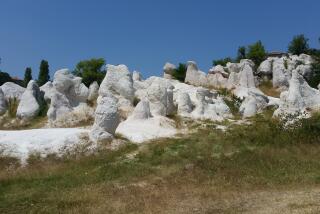STAGE REVIEW : ENDEARING PORTRAIT OF DICKINSON
- Share via
Julie Harris paid a visit to the Laguna Moulton Playhouse over the weekend in the guise of Emily Dickinson. Or was it the other way around? No matter. The actress and the poet have become inextricably entwined after 11 years together in “The Belle of Amherst,” and the Laguna Beach appearance vividly demonstrated why.
Perhaps the best tribute to this one-woman show is that it only whets the appetite to further explore the enigmatic Dickinson. And perhaps the best tribute to Harris is that it will be impossible to do that without recalling the stamp of her rich interpretation.
But then, tributes are nothing new to “The Belle of Amherst,”which has been around since 1976, nor to Harris, who won her fifth Tony Award for her portrayal of the shy spinster who left a legacy of haunting verse when she died in 1886. Harris has gone on to other roles in the past 11 years, both on television as Lilimae Clements in “Knots Landing” and on tour in “Bronte: A Solo Portrait of Charlotte Bronte,” among others. But for the Laguna Beach benefit, staged Saturday and Sunday to raise funds for the community theater building fund and endowment campaign, Harris revisited “Amherst” and offered up two hours of absorbing theater.
The immediate surprise Saturday in rediscovering “The Belle of Amherst” was how much humor playwright William Luce and Harris found in this intense woman. Luce has gracefully integrated observations from the poet’s personal correspondence with biographical information and excerpts from her work in his script, and Harris responds with an uncluttered performance, one that is spare but by no means unsparing.
It is an affectionate portrait from start to finish, and the humor underscores that affection. Small-town gossips, organized religion, self-righteous teachers and family eccentricities all provide grist for her ironic commentary, but they also illuminate Dickinson’s oblique relationship to the world around her and to the forces that motivated her retreat from that world.
Harris provides the illumination in deft details. The unaffected cadence of her speech leaves room for thought, even those annoying wisps that momentarily derail the poet’s train of thought. She edits as she speaks, deliberately sifting through adjectives until she finds just the right one. Dickinson viewed her own idiosyncrasies with bemusement, and Harris shows how much she enjoyed setting tongues wagging, taking pride in being different. Harris reserves a reverent tone for members of the poet’s family, neatly suggesting the forces that bound all three Dickinson children to Amherst for life.
She edges close to the pain in the quiet moments. “I’ve always been tense about relationships,” Dickinson explains, and Harris offers those words cautiously, in self-examination as much as in self-revelation.
But what comes through most vividly is a lingering sense of the child within the poet. Harris displays Dickinson’s wonder at the world as she follows a garter snake in the grass, spies on a spider in its web or describes a bird’s soliloquy. She also reveals a stubborn honesty that did not diminish with adulthood, reflected in a mind that questioned authority at the same time it clung fiercely to heroic visions of the important people in her life.
The format provides a good vehicle to trace the delicacy of Dickinson’s inner landscape. There is real pleasure in hearing what Harris finds in Dickinson’s words, investing them with nuance and logic that spring from the biographical context Luce has provided. (It may be speculative, but it works.)
Harris shifts gears with deceptive ease, moving back and forth in time with assistance from Stephen Wolff Craig’s fine lighting design. She takes the audience right along with her, from childhood to middle age, from parlor to garden to cramped bedroom, to the inner chambers that asked the questions her poetry would answer. It makes for a remarkable journey.
More to Read
The biggest entertainment stories
Get our big stories about Hollywood, film, television, music, arts, culture and more right in your inbox as soon as they publish.
You may occasionally receive promotional content from the Los Angeles Times.










